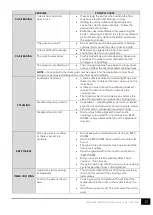
18
Sakura Multifunction Rice Cooker by Yum Asia
Surprisingly, you can also use chilli stalks (i.e. the green part that holds the chilli to the plant which you discard)
as a yoghurt starter. Chilli stalks contain bacteria lactobacillus and 10-15 chilli stalks in place of a yoghurt or
powdered starter work to develop any kind of milk into yoghurt.
Some tips for making yoghurt:
You can use yoghurt pots instead if you prefer, if you do this then fill the inner bowl to halfway up the pots with
hot water so the water conducts the heat to the pots.
For non-dairy yoghurts, use a milk which has as few additives as possible (e.g. soy milk without sugar or
vanilla, just soy beans and water should be listed on the ingredients, the same goes for other types of non-
dairy milks).
Always add flavour after the yoghurt has finished developing, if you are retaining some to use as your next
starter, set this aside in a separate pot before you add anything else to the yoghurt.
If your yoghurt is too thin next time you may need to add more ‘starter’ and also add 2 tablespoons of full fat
milk powder and mix well with the milk before adding the starter. UHT milk is used because it has already been
heated to a high temperature, but sometimes milk powder and more starter may be required.
For further tips on making yoghurt, please see www.greedypanda.co.uk
8. COOKING WITH OTHER GRAINS/PULSES IN SAKURA
It’s possible to cook other grains and pulses in Sakura, you may need to experiment with adjusting water levels
and selecting the correct cooking cycle. Here is a rough guide that may help.
QUINOA
If it’s not pre-washed, make sure you rinse it well in a sieve with cold water. Use a 1:1 ratio of quinoa to water
(up the water to 1:1.25 if you are using black quinoa) and use the quick cook setting. Once it’s finished cooking,
fluff up a little and leave on keep warm for 5-10 minutes.
COUS COUS and GIANT COUS COUS
Use the water levels indicated on the packet and use the quick cook setting as cous cous doesn’t require that
much cooking anyway.
MILLET
For each portion you want to cook, measure ¼ cup of millet into the inner bowl and add 1 cup water for each
portion (so if you use 1 cup of millet, add 4 cups water; for ¾ cup millet add 3 cups water; for ½ cup millet add 2
cups water and so on).
Shake a small dash of salt into the water, then close the lid. Plug in the rice cooker and select the ‘Porridge’
cycle. You can either cook straight away adjusting the timing for how you prefer your millet (longer cooking
will have a thicker consistency; less cooking will have a thinner consistency) or you can use the preset timer for
when you will want to eat in the morning. Once cooked you can add whatever flavouring you prefer.
LENTILS and BEANS
The slow cook setting is ideal for cooking lentils or beans – rinse beforehand and follow the water levels
indicated on the pack. The porridge setting also works for cooking lentils and beans if you want to cook at a
lower temperature.
PEARL BARLEY
The slow cook setting is ideal for cooking pearl barley - rinse before cooking and follow the water levels
indicated on the pack. Using pearl barley in a large batch of soup will cook within an hour but it won’t
overcook if left for longer.







































